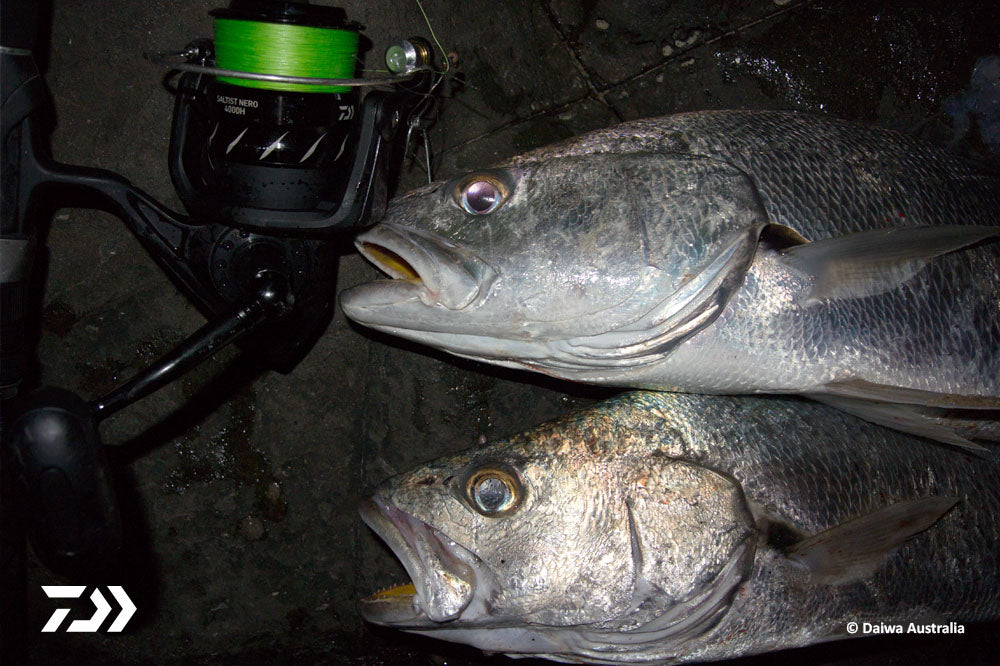DAIWA FISHING TIPS: School Jewfish – Kings of the Quick Fix – Dave Rae
Posted on
I love catching school jew. They fight hard and the first glimpse of the silver side, alight with jewie portholes is fantastic. Better than that though, is their tendency to behave with predictability. Crack the code and you can enjoy a session of 30 minutes duration with the expectation of returning home with a smelly schoolie hanging from your hand!
Jews are ambush hunters that feed in response to tide and light levels.
Off the rocks, peak feeding times are most likely to coincide with the low light of dawn and dusk whilst, more often than not, estuary hotspots turn on during the slack water of a tide change; irrespective of the time of day, although a dawn or dusk tide change is always the dream.
Rock fishing is my favourite form of schoolie fishing. I hit the rocks just before sunset or just before first light and I’ve lost count of how many schoolies have nailed the lure on the first cast. You don’t have long, perhaps 15-30 minutes max, so a quick hit and run session is idea if you are near the water.
Submerged crevices and caves are ideal if you can get to them with a lure. Wash covered gutters, amongst the rocks and boulder fields, at the extremities of beaches are also worth a look.
They love wash and whitewater, and as long as the surge is not excessively powerful, they will sit behind rocky outcrops and in deeper holes.

Safety becomes important in more turbulent conditions, so be sure that you have an escape route if the tide becomes too high or if the swell rises.
Hooking a big fish amongst the boulders is always a gamble, but you are more likely to connect with a sub-metre fish than a metre-plus thumper… but you never know!
Estuary hotspots are based around deep holes. Add in some form of structure, say a bridge pylon, rocks or a sandbar dropping into the deep, and you’ll probably encounter schoolies at some time.
As far as gear goes, I use 15kg braid for the mainline and the same strength fluorocarbon trace. The new J-Braid is a favourite as it’s thin and resistant to the bashing I’ve been giving it.
The rod is ideally 213-240 cm in length, any longer and I find it hard to hold whilst flicking a plastic. I’ll often use a Gen Black Supa Caster, which as the name suggests, casts a plastic a mile. It’s a light rod that rated to 10kg line, and whilst I’ve used it with a locked drag to pull a rampaging schoolie clear of danger, it’s coped really well. When combined with BLAST 3520PE spinning reel, I could fish all day; which is not what this blog is about by the way!

The Blast is a cracker of a reel. It is economical and smooth to use. It’s a sexy looking bit of gear, but best of all is the performance of its drag system. Loaded with the Ultimate Tournament Drag System (rated to 8kg), I can screw it down and still experience a smoothness that is quite surprising for a reel of this price.
Schoolies are pretty easy going when it comes to the choice of a soft plastic. Most mulloway anglers would agree that white/pearl are the premium colour. I’ve had success with all colours, but I do catch a lot of my fish on plastics that are either a white/pink or white/brown combination or a pearl glow tint. Atomic Plazos 7” Jerk Minnows, 7” Zerek Flat Shads and 6” Berkley Grubs are my go-to lures.
Always work the SP’s slow and near the bottom. Pass structure closely and expect to lose gear. Don’t worry too much though; because the schoolies will be right next to cover.
Good Luck!


 Wishlist
Wishlist

